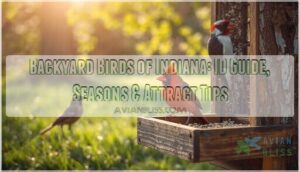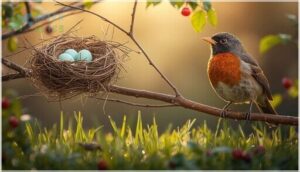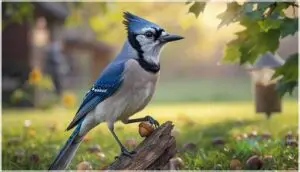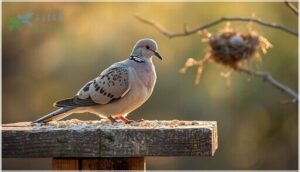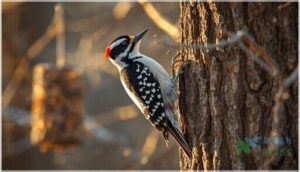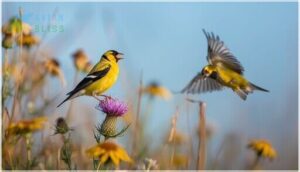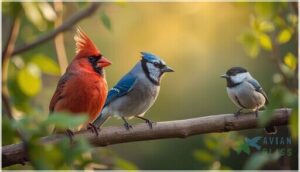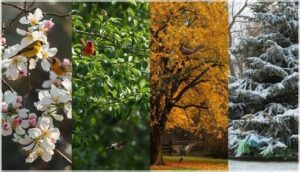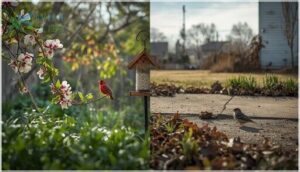This site is supported by our readers. We may earn a commission, at no cost to you, if you purchase through links.
Your morning coffee tastes better when a flash of cardinal red catches your eye at the feeder. Indiana backyards host an impressive variety of birds—from the cheerful trill of robins to the acrobatic woodpeckers spiraling up oak trees.
These feathered neighbors aren’t just pleasant to watch. They’re indicators of ecosystem health, natural pest controllers, and a direct connection to the wild rhythms happening right outside your window.
Learning to identify the backyard birds of Indiana transforms casual glances into meaningful observations. You’ll discover which species stick around all winter, which ones signal spring’s arrival, and how small changes to your yard can turn it into a haven for even more winged visitors.
Table Of Contents
- Key Takeaways
- Common Backyard Birds of Indiana
- Identifying Indiana Backyard Birds
- Seasonal Birds in Indiana Backyards
- Attracting Birds to Your Backyard
- Conservation and Challenges for Indiana Birds
- Frequently Asked Questions (FAQs)
- How do I identify a bird in my backyard?
- What is the most common bird in Indiana?
- What are the unusual birds in Indiana?
- What bird is native to Indiana?
- What are common backyard bird diseases?
- How do birds survive Indiana winters?
- Do backyard birds migrate from Indiana?
- What do baby backyard birds eat?
- How to safely clean bird feeders?
- What predators threaten Indiana backyard birds most?
- Conclusion
Key Takeaways
- Indiana’s backyards host year-round residents like Northern Cardinals and Blue Jays, plus seasonal migrants including Baltimore Orioles and Ruby-throated Hummingbirds that transform yards into critical stopover habitats during spring and fall migrations.
- You can identify backyard birds by focusing on visual characteristics like plumage color and bill shape, distinctive calls such as the cardinal’s “birdie, birdie” song, and behavioral patterns including foraging techniques and territorial defense.
- Attracting more bird species requires combining black oil sunflower seeds and suet feeders with fresh water sources changed every 48 hours, plus native plants like serviceberry that provide the insects and seeds birds evolved to eat.
- Indiana’s birds face serious threats from habitat loss (contributing to North America’s 2.9 billion bird decline since 1970) and disease outbreaks at poorly maintained feeders, making regular cleaning every two weeks and supporting conservation efforts essential for their survival.
Common Backyard Birds of Indiana
Indiana’s backyards are bustling with winged visitors, from the flashy red cardinal to the cheerful goldfinch. You’ll spot some of these birds year-round, while others drop by with the changing seasons.
Let’s look at seven species you’re most likely to see outside your window.
Northern Cardinal
The Northern Cardinal is Indiana’s most recognizable backyard bird, with males sporting vivid scarlet plumage year-round. You’ll spot these permanent residents daily, enjoying:
- Black oil sunflower seeds at feeders
- Dense shrubs for nesting sites
- Insects during breeding season
- Early morning and late afternoon feeding times
Their stable populations thrive thanks to your backyard support. Cardinals get their color from carotenoids in their diet.
American Robin
You’ll recognize the American Robin by its brick-red chest and cheerful song echoing through Indiana yards year-round. These thrushes, one of North America’s most abundant bird species with 370 million individuals, forage on your lawn for earthworms and insects. Watch them pause and tilt their heads while hunting.
Robins nest twice each season, laying distinctive pale blue eggs in mud-lined cups tucked into tree branches. They’re known to have a diet of insects, berries, and earthworms.
Blue Jay
While Robins patrol your grass, look up for the striking Blue Jay—a year-round Indiana resident sporting vivid blue feathers and bold white markings. These intelligent birds aren’t just pretty faces:
- They mimic hawk calls to scatter competitors at feeders
- They cache thousands of acorns yearly, planting future oak forests
- Their complex social behavior includes mate cooperation and alarm calls
You’ll attract them with shelled peanuts and sunflower seeds, though Blue Jay populations have declined 25% since 1970.
Mourning Dove
You’ll often hear the Mourning Dove before spotting it—a gentle, mournful coo drifting through your yard. This slender backyard bird with tan-gray plumage stays year-round in Indiana, though some migrate south in fall.
Their diet consists almost entirely of seeds, so scatter white millet or cracked corn on platform feeders. Doves build flimsy twig nests and raise multiple broods from April through October.
House Sparrow
House Sparrows are the scrappy survivors you’ll spot hopping around parking lots and porches. These non-native common backyard birds in Indiana show strong urban adaptation, thriving where people live. Males sport black bibs and gray caps, while females wear plain brown.
Their nesting competition often harms native species, and despite an 80% population decline since 1966, they remain abundant. Bird identification is easy—watch for their bold, feisty behavior at feeders. Their dietary habits include seeds and insects.
Downy Woodpecker
With a black-and-white checkered back and small red patch (on males), the Downy Woodpecker ranks among the most common backyard birds you’ll identify in Indiana. This permanent resident thrives across habitat diversity—from forests to suburban yards—making backyard bird identification easy.
Watch their feeding adaptations as they tap bark for beetles and ants, or visit your suet feeder. Their conservation status remains stable, with population trends showing resilience.
American Goldfinch
You’ll spot the American Goldfinch by its striking summer plumage—males flash bright yellow with black wings and forehead. This backyard bird undergoes molting twice yearly, shifting to olive-brown winter tones. Watch for these Indiana favorites:
- Seed preferences: Thistle and sunflower seeds dominate their vegetarian diet
- Flight calls: Listen for “per-twee-twee-twee” patterns
- Nesting habits: Single broods in shrub-level nests
- Undulating flight: Wave-like patterns identify them instantly
- Year-round presence: Reliable feeder birds across all seasons
Identifying Indiana Backyard Birds
Learning to identify backyard birds doesn’t have to feel overwhelming. You can start with a few simple clues that help distinguish one species from another, even if you’re brand new to birdwatching.
Let’s look at the key features that make identification easier and more rewarding.
Visual Characteristics
You can quickly learn bird identification by focusing on plumage coloration and feather structure. Each species shows distinct patterns, like the cardinal’s vivid red or the robin’s rusty breast. Sexual dimorphism helps too; males often sport bolder colors than females. Juvenile markings differ from adults, so watch for those changes.
Here’s a quick comparison:
| Feature | Northern Cardinal | American Robin |
|---|---|---|
| Male Color | Scarlet-red | Gray-black head, orange breast |
| Female Color | Olive-gray, dull red wings | Similar but duller |
| Bill Shape | Stout coral-red | Yellow with dark tip |
| Size | Medium | 10 inches long |
Bird Calls and Songs
Bird song identification sharpens your birdwatching skills fast. Northern Cardinals repeat clear “birdie, birdie” songs, while American Robins deliver melodious phrases at dawn. Blue Jays display impressive call diversity, including hawk mimicry behaviors. Mourning Doves produce soft five-note coos in early morning.
Song frequency peaks during spring migration, and urban impact raises pitch by 12–19%. Seasonal variations bring louder alarm calls during fall competition.
Behavior and Habits
Watching your backyard birds reveals fascinating patterns beyond feathers and songs. Each species brings distinct foraging techniques, nesting strategies, and social interactions that make identification easier once you know what to look for.
- Territorial defense – Cardinals aggressively patrol 3-6 acre zones, while Blue Jays alert communities with mimicked hawk calls
- Bird feeding habits – Robins spot earthworms visually on open lawns; House Sparrows hop in flocks competing at feeders
- Bird nesting behavior – Mourning Doves raise up to six broods yearly in simple platform nests
- Flocking behavior – Cardinals gather in winter groups, contrasting their solitary breeding season territorial behavior
Seasonal Birds in Indiana Backyards
Indiana’s backyard bird scene changes with the calendar, and knowing what to expect each season can help you spot new visitors and understand when your regulars might disappear for a while.
Some birds stick around all year, while others only show up when the weather shifts or breeding season kicks in.
Let’s break down which species you’ll see during different times of the year.
Year-round Residents
Throughout every season, several reliable friends stay put in your Indiana backyard. The Northern Cardinal, Blue Jay, Downy Woodpecker, House Sparrow, and American Goldfinch maintain stable populations year-round. Understanding these species’ behaviors and adaptations helps with year-round bird support.
Cardinal behavior includes defending territories, while Jay habitats span woodlands to suburbs. Goldfinch flocks can gather by the dozens at feeders.
| Species | Key Feature |
|---|---|
| Northern Cardinal | State bird, vibrant red plumage |
| Blue Jay | Bright blue feathers, distinctive calls |
| American Goldfinch | Often seen in large flocks |
Understanding Sparrow Adaptations and Woodpecker Diets further enhances our ability to support these backyard birds throughout the year.
Winter Visitors
When colder weather arrives, you’ll notice new Indiana bird species joining your backyard regulars. Dark-eyed Juncos are among the most common winter birds, with over 25,000 counted statewide each season. These winter visitors showcase fascinating feeder preferences and winter behavior patterns.
Notable rarities like Snowy Owls occasionally appear during irruptive migrations. Population counts reveal that more than 60% of households increase feeding activity to support these seasonal backyard birds, making winter bird identification especially rewarding.
Spring and Summer Migrants
As spring arrives, Indiana becomes a highway for millions of migratory birds passing through each night. From April through May, you’ll spot colorful new visitors like Baltimore Orioles, Indigo Buntings, and Ruby-throated Hummingbirds stopping in your yard. Peak migration timing brings striking diversity:
- Early May averages 4.5 million birds nightly over Indiana
- Mid-May peaks can reach 10 million individuals
- June marks breeding behavior as many migrants stay to nest
These spring birds rely on your backyard’s stopover habitats during their amazing journey north.
Fall Migratory Species
After summer nesting wraps up, fall migration transforms your backyard into a rest stop for travelers heading south. From August through October, you’ll see warblers, thrushes, and ruby-throated hummingbirds refueling during nocturnal flight.
Peak September nights bring over 376 million songbirds across Indiana skies. These migratory birds need stopover habitats desperately—light pollution and habitat loss threaten their journeys, making your yard’s resources essential.
Attracting Birds to Your Backyard
Turning your backyard into a haven for birds doesn’t require a lot of fancy equipment or expert knowledge. With a few simple additions like the right food, fresh water, and thoughtful landscaping, you can welcome a surprising variety of species right to your doorstep.
Here’s what works best to get Indiana’s backyard birds coming back again and again.
Bird Feeders and Food Types
You can turn your backyard into a haven by choosing the right feeders and foods. Black oil sunflower seeds attract cardinals and finches—94% of Indiana birders rely on them. Peanuts draw Blue Jays, while suet keeps woodpeckers coming back during winter months.
- Platform feeders accommodate doves and heavier ground-feeding species
- Tube feeders bring in goldfinches and attract diverse finch populations
- Regular feeder maintenance every two weeks cuts disease incidents by 65%
- Offering three distinct food types boosts bird diversity by 56%
Providing Water Sources
Birds need water just as much as food—offering a fresh source can double cardinal and Blue Jay visits to your Indiana backyard.
Choose a shallow basin 12 to 18 inches wide and place it within 10 feet of cover for safety. Change water every 48 hours to prevent disease, and consider adding a dripper—it attracts 40% more species than still baths.
Native Plants and Landscaping
When you plant native Indiana species like serviceberry or winterberry holly, you’re building a backyard birds buffet that spans all seasons. Yards with 70% native plants support thriving populations because they foster the insects and seeds birds actually evolved to eat.
Cluster different shrubs together—think gray dogwood paired with arrowwood viburnum—to create the habitat complexity that attracts Cardinals, Goldfinches, and migrating warblers year-round.
Safe Nesting Sites
Installing nest boxes 4–6 feet high with eastward-facing entrances boosts fledging success for backyard birds by 18% and provides predator protection for native species like tree swallows. Position them 10–12 feet from shrubs to reduce hazard reduction concerns, and keep bird habitats away from high-traffic areas—human disturbance can drop nesting success nearly 30%.
Proper nest box design and habitat placement transform your yard into a thriving backyard wildlife sanctuary.
Conservation and Challenges for Indiana Birds
While backyard birding brings joy to thousands of Indiana residents, the birds themselves face some serious hurdles. From shrinking habitats to unexpected disease outbreaks, these challenges affect both common and rare species across the state.
Here’s what you need to know about protecting the birds that visit your yard and how you can make a real difference.
Habitat Loss and Urbanization
Since 1970, North America has lost over 2.9 billion birds, and your Indiana backyard reflects that troubling shift. Urban sprawl and habitat fragmentation have pushed out native species while suburban bird populations adapt or vanish.
Since 1970, North America has lost 2.9 billion birds, and urban sprawl is pushing native species out of Indiana backyards
Grasslands have suffered the steepest declines, affecting rural bird populations that depend on open spaces.
Conservation efforts like habitat restoration and bird-friendly land conversion can reverse these losses in your backyard garden ecosystem.
Disease and Feeder Management
Protecting your feathered visitors means taking disease transmission seriously. More than 93,000 birds in Indiana were affected by avian influenza in 2025, while salmonella, trichomoniasis, and aspergillosis spread at poorly maintained feeders. Here’s how you prevent outbreaks and manage zoonotic risks:
- Clean seed and suet feeders every two weeks with soap and 10% bleach solution
- Scrub hummingbird feeders weekly due to rapid bacterial growth
- Position feeders 30 feet from windows in direct sunlight
- Remove sick or dead birds immediately and report them to Indiana DNR
Supporting Conservation Efforts
You can extend conservation efforts beyond your backyard by supporting habitat restoration programs that combat habitat loss across Indiana. Private landowners hold 97% of the state’s forests, making community engagement essential for bird conservation efforts and measurable outcomes.
Your donations fund grassland projects that have recovered Henslow’s Sparrow populations while boosting local economies through nature tourism—strengthening both bird populations and backyard garden ecosystems statewide.
Citizen Science Opportunities
You can turn your backyard bird watching into meaningful conservation data through several established programs. Each observation strengthens bird conservation efforts statewide.
Here are five ways to contribute:
- Project FeederWatch – Track winter visitors November through April
- eBird usage – Document backyard bird sightings year-round
- Christmas Count – Join participants averaging 15+ years of volunteer impact
- MAPS banding – Support Indiana’s 30+ monitoring stations
- Great Backyard Bird Count – Submit FeederWatch data each February
Your birdwatching directly informs conservation strategies across Indiana.
Frequently Asked Questions (FAQs)
How do I identify a bird in my backyard?
Look at size, shape, and colors first—97% of birdwatchers start there. Listen for distinctive calls like the cardinal’s “cheer-cheer-cheer.” Watch how birds move and feed. Mobile apps help confirm tricky identifications when you’re stuck.
What is the most common bird in Indiana?
Without a doubt, the Northern Cardinal reigns as Indiana’s most common backyard bird. FeederWatch data shows cardinals at 98% of surveyed sites statewide—far exceeding American Robins and other familiar species year-round.
What are the unusual birds in Indiana?
Indiana’s unusual birds include rare vagrants like the Brown Booby and endangered species such as the Loggerhead Shrike.
Over 133 species are officially rare, requiring documentation by the Indiana Bird Records Committee for verification.
What bird is native to Indiana?
Think of Indiana’s native birds as feathered neighbors who’ve called this place home for generations.
The Northern Cardinal stands out among 422 documented species, thriving year-round with considerable population stability and abundance throughout regional diversity.
What are common backyard bird diseases?
Your backyard wildlife faces threats like Avian Influenza, House Finch Conjunctivitis, Trichomoniasis, and mysterious Songbird Mortality events.
These Avian Diseases affect Common Backyard Birds, making Avian Disease Prevention essential for protecting Avian Species you love.
How do birds survive Indiana winters?
When the going gets tough, the tough get going”—and your backyard birds prove it. Indiana winter birds survive through metabolic adaptations, roosting shelters, huddling behavior, winter diets from feeders, and migration patterns ensuring year-round bird support.
Do backyard birds migrate from Indiana?
Yes, many species migrate. American Robins, Indigo Buntings, and Wood Thrushes head south in fall, while Northern Cardinals and Blue Jays stay year-round.
Seasonal bird activity varies widely across Indiana’s backyard birds.
What do baby backyard birds eat?
Ironically, those adorable baby birds don’t want seeds. They need protein-packed insects—caterpillars, beetles, and earthworms—delivered every 20–45 minutes.
Parents regurgitate or bring whole prey, depending on the nestling’s age and species.
How to safely clean bird feeders?
Scrub your feeders every two weeks with hot water, soak them in a bleach solution (one part bleach to nine parts water) for 10 minutes, rinse thoroughly, and air-dry completely before refilling.
What predators threaten Indiana backyard birds most?
Let’s face it—our feathered friends aren’t always safe in their own neighborhoods. Domestic cats top the list, followed by avian raptors like hawks and owls, plus invasive species threatening bird habitats daily.
Conclusion
They say birds only visit yards with perfect habitats—but your Indiana backyard already has potential. Even a single feeder or native shrub can draw in cardinals, goldfinches, and robins.
Understanding backyard birds of Indiana means recognizing that small, intentional changes create big impact. You’re not just watching birds—you’re participating in their survival. Start with one adjustment today, and you’ll transform your yard into a destination worth their journey.
- https://www.in.gov/dnr/fish-and-wildlife/nongame-and-endangered-wildlife/birds/
- https://data.statesmanjournal.com/most-sighted-winter-and-spring-birds/location/indiana/18/february/
- https://www.youtube.com/watch?v=gwFPxAYGoKo
- https://data.usatoday.com/most-sighted-winter-and-spring-birds/location/marshall-county/18099/may/?query=&page=
- https://indianaaudubon.org/backyard-birds-of-indiana/

